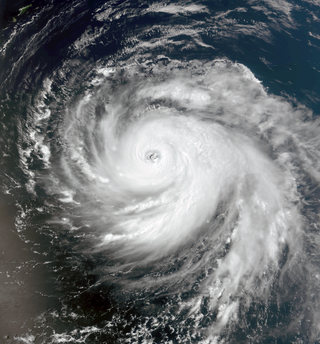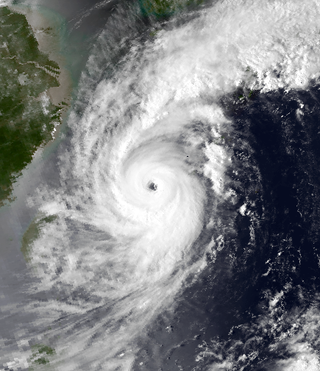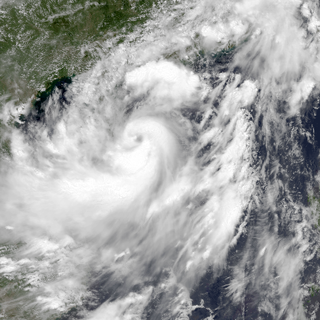
The 2006 Pacific typhoon season was a near-average season which produced a total of 23 named storms, 15 typhoons, and six super typhoons. The season ran throughout 2006, though most tropical cyclones typically develop between May and October. The season's first named storm, Chanchu, developed on May 9, while the season's last named storm, Trami, dissipated on December 20.

The 1990 Pacific typhoon season was another active season. It has no official bounds; it ran year-round in 1990, but most tropical cyclones tend to form in the northwestern Pacific Ocean between May and November. These dates conventionally delimit the period of each year when most tropical cyclones form in the northwestern Pacific Ocean.

Severe Tropical Storm Kammuri, known in the Philippines as Tropical Storm Lagalag, killed hundreds of people in the wake of a deadly flood season in China. The system developed from a large monsoonal system that persisted toward the end of July 2002 near the Philippines. On August 2, a tropical depression formed off the northwest coast of Luzon and moved west-northwestward. Late on August 3, it intensified into Tropical Storm Kammuri off the coast of Hong Kong. A weakening ridge turned the storm northward toward the coast of China. The storm made landfall with late on August 4, after reaching peak winds of 100 km/h (65 mph). The system dissipated over the mountainous coastline of eastern China and merged with a cold front on August 7.

Severe Tropical Storm Bilis, known in the Philippines as Tropical Storm Florita, was a weak tropical cyclone in July 2006 that caused catastrophic damage to areas of the Philippines, Taiwan, and southeastern China. The word Bilis, submitted by the Philippines, means 'speed' or 'swiftness' in Tagalog.

Typhoon Durian, known in the Philippines as Super Typhoon Reming, was a deadly tropical cyclone that wreaked havoc in the Philippines and later crossed the Malay Peninsula in late November 2006, causing massive loss of life when mudflows from the Mayon Volcano buried many villages.

An earthquake occurred in the province of Sichuan, China at 14:28:01 China Standard Time on May 12, 2008. Measuring at 8.0 , the earthquake's epicenter was located 80 kilometres (50 mi) west-northwest of Chengdu, the provincial capital, with a focal depth of 19 km (12 mi). The earthquake ruptured the fault for over 240 km (150 mi), with surface displacements of several meters. The earthquake was also felt as far away as both Beijing and Shanghai—1,500 and 1,700 km away, respectively—where office buildings swayed with the tremor, as well as Bangkok, Thailand and Hanoi, Vietnam. Strong aftershocks, some exceeding 6 , continued to hit the area up to several months after the main shock, causing further casualties and damage. The earthquake also caused the largest number of geohazards ever recorded, including about 200,000 landslides and more than 800 quake lakes distributed over an area of 110,000 km2 (42,000 sq mi).

Typhoon Prapiroon, known in the Philippines as Tropical Storm Henry, was a minimal typhoon which caused deadly flooding in southern China in August 2006. Prapiroon developed out of a persistent area of convection accompanied by an area of low pressure on July 25 about 120 km (75 mi) west-southwest of Yap. Two days later, both the Japan Meteorological Agency (JMA) and PAGASA classified the system as a tropical depression, with PAGASA giving it the local name 'Henry'. By July 31, the Joint Typhoon Warning Center (JTWC) classified the system as Tropical Depression 07W. A strong subtropical ridge located to the north of the depression led to a west-northwest movement for most of the storm existence.

Severe Tropical Storm Zita, known in the Philippines as Tropical Storm Luming, was a short-lived tropical cyclone that killed seven people throughout southern China in August 1997. Originating from a tropical disturbance over the South China Sea on August 19, Zita tracked westward as it quickly strengthened within a region of light wind shear, attaining winds of 140 km/h (85 mph) as it made landfall along the Leizhou Peninsula early on August 22. Maintaining this intensity, the storm made a second landfall in northern Vietnam later that day before rapidly weakening over land. The remnants of Zita were last noted over extreme northwestern Vietnam on August 24.

Typhoon Rananim, known in the Philippines as Typhoon Karen, was the strongest typhoon to make landfall on the Chinese province of Zhejiang since 1956. It formed on August 6, 2004, intensifying into a tropical storm on August 8. Rananim gradually intensified, initially moving northward before turning to the northwest and attaining typhoon status. After developing a small eye, the typhoon attained peak winds of 150 km/h (93 mph) as it passed between Taiwan and Okinawa. On August 12, Rananim moved ashore in China, and it dissipated three days later. The name Rananim means "hello" in the Chuukese language.

Severe Tropical Storm Nock-ten, known in the Philippines as Severe Tropical Storm Juaning, was a strong tropical storm which made a total of four landfalls in Southeast Asia, killing more than 100 people and causing damage estimated at US$126 million. It was the eighth named storm and the fourth severe tropical storm of the 2011 Pacific typhoon season.

Typhoon Damrey, known in the Philippines as Typhoon Labuyo, was a typhoon that hit Vietnam and China in September 2005. The typhoon was the most powerful storm to affect Hainan in over 30 years, killing more than 113 people.

Typhoon Soulik, known in the Philippines as Super Typhoon Huaning, was a powerful tropical cyclone that caused widespread damage in Taiwan and East China in July 2013. The storm originated from an upper-level cold-core low well to the northeast of Guam on July 6. Gaining tropical characteristics, the system soon developed a surface low and became a tropical depression early on July 7. Tracking generally westward, a motion it would retain for its entire existence, the depression underwent a period of rapid intensification starting on July 8 that culminated in Soulik attaining its peak strength early on July 10. At that time, the system had sustained winds estimated at 185 km/h (115 mph) and barometric pressure of 925 mbar. Thereafter, an eyewall replacement cycle and cooler waters weakened the system. Though it passed over the warm waters of the Kuroshio Current the following day, dry air soon impinged upon the typhoon. Soulik later made landfall late on July 12 in northern Taiwan before degrading to a tropical storm. Briefly emerging over the Taiwan Strait, the storm moved onshore for a second time in Fujian on July 13. The system was last noted as a tropical depression early on July 14.

Typhoon Yancy, known in the Philippines as Typhoon Tasing, was one of the costliest and most intense tropical cyclones to strike Japan on record. Yancy was the sixth typhoon of the annual typhoon season and sixth tropical cyclone overall to impact Japan that year. Developing out of an area of disturbed weather in the open northwest Pacific on August 29, 1993, the precursor to Yancy tracked westward and quickly intensified to reach tropical storm strength on August 30. Just two days later, the tropical storm reached typhoon intensity as it recurved towards the northeast. A period of rapid intensification followed, allowing Yancy to quickly reach super typhoon intensity. The strong tropical cyclone reached peak intensity on September 2 with maximum sustained winds of 175 km/h (109 mph). The following day Yancy made its first landfall on Iōjima at nearly the same strength; over the course of the day the typhoon would make three subsequent landfalls on Japanese islands. Land interaction forced the tropical cyclone to weaken, and after its final landfall on Hiroshima Prefecture, Yancy weakened below typhoon intensity. After emerging into the Sea of Japan, Yancy transitioned into an extratropical cyclone; these remnants persisted as they meandered in the sea before dissipating completely on September 7.

Severe Tropical Storm Jebi, known in the Philippines as Tropical Storm Jolina, was a tropical cyclone that caused loss of life and moderate damage across Vietnam and South China in July 2013. At least six people were killed in Vietnam. The most extensive losses took place in Quảng Ninh Province where 320 homes and 200 hectares of crops were damaged. In China, losses were listed at CNY490 million.

Typhoon Abe, known as Typhoon Iliang in the Philippines, was the fourteenth named storm of 1990 Pacific typhoon season. Forming on August 23 from a tropical disturbance, the depression which would eventually develop into Typhoon Abe initially tracked in a steady west-northwestward direction. As a result of an intense monsoon surge, Abe's trajectory briefly changed to an eastward then northward path before returning to its original track. Abe only intensified by a small amount between 00:00 UTC August 24 and 06:00 UTC August 27 due to the disruptive effects of the surge, and on August 30, Abe peaked in intensity as a Category 2-equivalent typhoon on the Saffir–Simpson hurricane wind scale. After peaking in intensity, Abe crossed the Ryukyu Islands and the East China Sea, making landfall in China where it affected the provinces of Zhejiang and Jiangsu before entering the Yellow Sea, crossing South Korea, and finally transitioning into an extratropical cyclone.

Hispaniola is an island in the Caribbean, with the second largest size throughout all of the Caribbean. Throughout the centuries, since reliable records began, hundreds of hurricanes and tropical cyclones have affected Haiti and the Dominican Republic, the two countries that share the island. The most recent tropical cyclone to affect Hispaniola was Hurricane Franklin in August 2023.

Tropical cyclones regularly affect the coastlines of most of Earth's major bodies of water along the Atlantic, Pacific, and Indian oceans. Also known as hurricanes, typhoons, or other names, tropical cyclones have caused significant destruction and loss of human life, resulting in about 2 million deaths since the 19th century. Powerful cyclones that make landfall – moving from the ocean to over land – are some of the most impactful, although that is not always the case. An average of 86 tropical cyclones of tropical storm intensity form annually worldwide, with 47 reaching hurricane/typhoon strength, and 20 becoming intense tropical cyclones, super typhoons, or major hurricanes.

The Korean Peninsula is a peninsula region located over Eastern Asia. The region is divided into North Korea and South Korea.

Vietnam is a southeast Asian country, and is the easternmost country of mainland Southeast Asia. It borders the East Sea, hence, seeing the increased likeliness of tropical cyclones. Tropical cyclones in this area are considered to be part of the Northwest Pacific basin, and therefore, storms here are considered as typhoons.



















